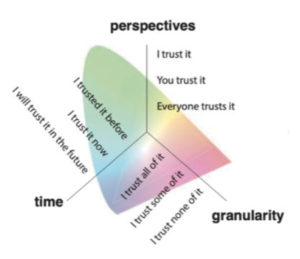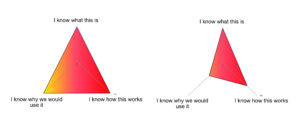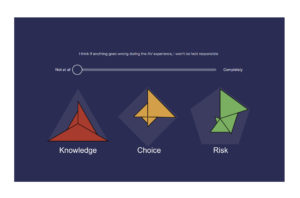Trust me? (I’m an autonomous machine) project blog | Written by Joseph Lindley, Project Lead, and Franziska Pilling, PhD Candidate and Project Research Associate| March 2022
This project aims to understand the gap between expert and everyday peoples’ views of Trust in the context of Autonomous Systems—things like self-driving cars, product recommendation systems, or automatic checkouts. We are working towards a common Master Narrative that unites these two points of view.
The first phase of the project involved consulting Autonomous Systems experts. A wide range of TAS hub members and partners came together in the summer of 2021 in a workshop designed to understand the depth and complexities of Trust. The outcomes of that workshop led to the idea of ‘Trust as Distributed Concern’. This way of thinking about it says that Trust is rarely ‘on’ or ‘off’ but is better described as a point of a scale. It also suggests that different people may trust the same thing differently. During the second phase of the project, we will design a way to test this way of thinking with everyday people and gather feedback.
We settled on the idea of a Trust Gamut as a way to capture the complete range or scope of trust. This way of thinking was useful because a gamut is a collection of different spectrums, so with a gamut we could show multiple scales all at the same time. The prototype trust gamut below was based on conversations at the workshop, which seeks to represent how trust changes based on perspective, time, and granularity.

[Image: Trust as a distributed concern]
Based on further analysis of the workshop transcripts we established thirteen trust gamuts, each one representing the intricacies and nuances of trust our experts discussed. Although it is based on many valid expert views, building such a complicated and multi-faceted notion of trust made our gamuts unreadable. We needed a simpler solution.
Through an iterative design process, we sought to reduce the number of gamuts, finally arriving at a three:
- Knowledge: what is known about this system, how it works, and why it is in use?
- Choice: is this system desirable, is it useful, and is it optional?
- Risk: is this system safe, is somebody overseeing it, and who does it pose risk to?
Each of these gamuts can be represented using a 2-dimensional shape.

[Image above: (Right) Complete Knowledge gamut with comparison (Left) gamut showing how the gamut adapts to value input]

[Image above: Evolution of trust gamuts, with the final form on the far left. The final trust gamuts are divided up into segments that fill up from the centre based on the value input kii]
We will use these shapes alongside a story, which tells the tale of a journey in an autonomous vehicle. As they progress through the story, at key points we will ask members of the public to complete the three trust gamuts. At the end of the story, the various values provided for each gamut will be compiled together and formed into a unique three-dimensional shape—the shape of that person’s trust.

[Image above: Test interface showing three complete gamuts with the slider at the top to input/fill-up the gamuts segments based on presented questions.]